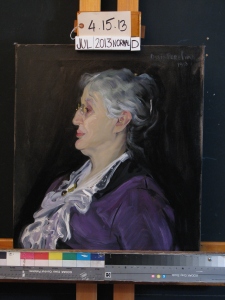Kaoka, the brainchild of Henry Wood Booth, came about after a doctor suggested that he quit drinking caffeine and gave Booth a recipe for “bran coffee.” Since Booth and his children all liked the beverage, he determined one night that it might make a good business venture. He experimented with various roasting pans– even one in the form of a coffee roaster which was a failure as “it nearly blew up with the generated steam.” Booth finally made one that roasted to his satisfaction and the family gathered together to name this new beverage and “Kaoka” was born. Wrappers were printed and family members made paper boxes to put in local grocery stores.
On June 10, 1879, a patent was issued to the Kaoka Manufacturing Company in St. Thomas, Ontario. Booth located a building and fitted it with a large steam engine and boiler and seven roasters which ran day and night. In addition to the male employees, seventy-five women were employed (to make boxes), and soon a joint stock company was formed. Booth was retained as the manager of the plant and also served as the public relations “salesman.” In November 1879, Booth set up a display at the First Annual Exhibition of the Agricultural and Industrial Exhibition Association of Toronto with a “kaoka coffee pot” and gave away free samples of the drink. A local newspaper reported that “kaoka was found to be palatable and quite fit – at least with a large number of people – to be used as a regular beverage.”
In 1880, the company’s directors asked Booth to go to Detroit in order to establish the business in the United States. However, Booth made the decision (which he later deemed “unwise”) to strike out on his own and set up the American business for himself, and sold his interest in the Canadian venture. After several set-backs, and his money ran out, Henry Wood Booth got out of the Kaoka business and went to work for the United States Post Office. The Detroit venture was, however, what ultimately relocated the Booth family to Detroit. And, Henry Wood Booth was considered the originator of the commercial cereal beverage.
Sidebar: during the time the company was trying to set up the Detroit enterprise, two men who had worked at the Kaoka plant in St. Thomas went to Battle Creek and established the cereal drink under a new name!
– Leslie S. Edwards, Head Archivist









